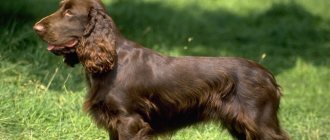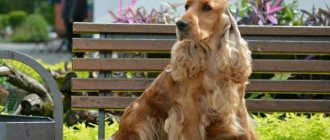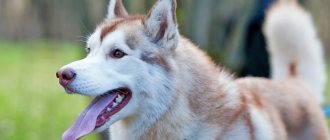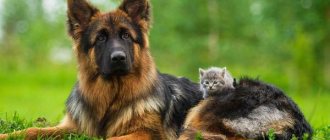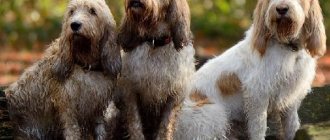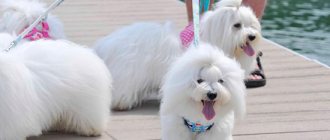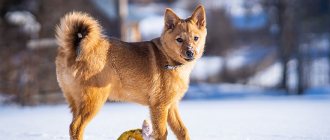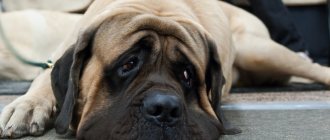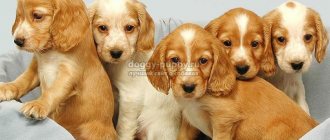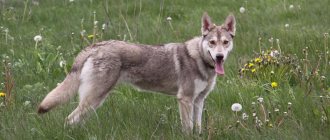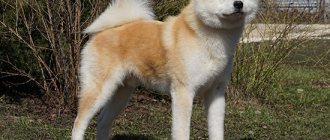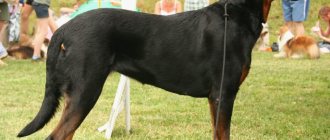Its main feature, perhaps, is its extraordinary beauty and decorativeness. At the same time, she retains the reputation of a strong and courageous, active and intelligent dog. The Cocker Spaniel dog breed has two varieties - English and American. It is worth noting
, that there is also an unofficial name for another type of spaniel -. What are the differences between these types?
The smallest fox weighs less than 3 pounds
Today the breed is the 30th most popular registered breed in the United States.
Arctic foxes will not flinch down to -70 degrees Celsius
The Arctic fox, which lives in the northernmost regions of the hemisphere, can handle the cold better than most animals on Earth.
It doesn't even cool down to -70 degrees Celsius. Its white coat also camouflages it against predators. As the seasons change, the fur also changes, becoming brown or gray, so the fox can blend into the rocks and dirt of the tundra. Many argue that this is the same dog, and the difference between them is purely external: the English Cocker Spaniel has a more elongated muzzle, while the American Cocker Spaniel has a deeper, or snub-nosed muzzle. This also occurs, but experts divide them into other positions.
“Cockers” date back to England in the Victorian era – XVII-XVIII centuries. Engravings of this period, depicting scenes from social or hunting life, most often depict Cocker Spaniel dogs. A little later, American breeders also became interested in her. Further selection of the breed took different paths, hence the slight differences in the exterior and characters of the two species.
Fox hunting continues to be controversial
Perhaps due to the fox's ability to destroy a henhouse, fox hunting became a popular activity in Britain in the 16th century. Currently, fox hunting with dogs is prohibited.
Fox appears in folklore
Finnish believed that the fox made the Northern Lights by running through the snow so that his tail swept sparks into the sky.
From this we get the phrase “fox fires.” Spaniels of all types were recognized in literature as early as the 14th century. Spaniels were divided into water spaniels and land spaniels, and it was the latter of these that received the following classification, which produced the Springfian spaniel, the field or cocker spaniel, and the toy or Maltese spaniel. Field or Cocker Spaniels were further divided by size and weight, with the larger members becoming Field Spaniels and the middle members becoming Sussex Spaniels and the smaller members eventually becoming Cocker Spaniels.
The breed characteristics that distinguish an American Cocker from an Englishman are especially expressive in appearance. The American Spaniel is a typical small-sized hunting dog, strong, hardy and very fast in movement.
If necessary, it fulfills its purpose
- stalk, frighten and present game. An extraordinary sense of smell is another distinctive feature of the breed, which also speaks of hunting instincts. Alas, medieval hunting is a thing of the distant past, and now “hunters” are most often forced to content themselves with the role of a decorative lap dog.
Cross-breeding between all groups was common, and each littermate was sorted and classified into the appropriate "breed pool". This is where we begin to compare the two cocker breeds we have today. Many of these dogs were descendants of the dominant black field spaniel, which was considered tall in the leg and somewhat "lottery" in the head. This was the beginning of the American Cocker Spaniel type, which is now classified in this country as the Cocker Spaniel. Meanwhile, in England, breeders recognized that the long, low cocker was not effective in this area, so they began to develop a more useful cocker, making it taller, more compact, more durable and with a longer neck to achieve shooting game. .
The cocker spaniel seems especially picturesque because of its long, silky coat without curls. The coat color is usually black, or black with white or fawn spots. Its height at the withers is no more than 38 cm, weight – no more than 12 kg.
The English Cocker Spaniel dog breed is slightly larger in size than its American counterpart - 38-41 cm in height and 12-16 kg in weight. She has developed muscles, a strong physique, and an even head posture. The ears are long, covered with thick hair, the tail is also long, but usually it is docked in half. The hair on the body is long, slightly wavy, without curls. The color is most often black, black and fawn or black and red.
So what is the point of this story? Suffice it to say, not long ago these two breeds were the same breed. Consequently, they share many characteristics and their standards read the same in many places. When designing a comparative study, common characteristics may be interesting, but differences are most important.
Nothing is more enjoyable than breeds with a globally homogeneous appearance and breeders who all strive for the same ideal. This allows for a wider range of breeding programs and allows the dog to be shown to judges from all over the world. Exhibitors can also exhibit all over the world and make friends.
This dog is characterized by inexhaustible energy and activity, it is able to accompany its owners for a long time, whether on a hunt, on a walk in the park or in the forest, or simply in outdoor games with children in the house or in the yard. She is restless and cheerful.
If the purpose of purebred dog breeding is to improve and promote the chosen breed, will the goal be compromised if the idea of the breed ideal varies from country to country? When are the typical traits so different that you might think they are different breeds? For over a hundred years, there have been distinctions between "working type" and "show type" in different breeds. But if the "show type" continues to change so much that it may become a new breed, have the breeders done their job wrong?
For example, the Cardigan Wales Corgi came to America in the early 1930s. One of the first estates was the bitch Cassie, who was also a British bloodline bitch. American breeders couldn't have started better. In the 70s, there was rumored to be an "American counter-English" type of cardigan. What if American breeders took the breed in a new direction that deviated from the original import? In fact, it was the opposite situation. There were many Cardigans in the 1970s whose ancestral plates went back to the earliest imports and also looked very similar to the first imported dogs.
What is especially captivating is her intelligent eyes, with which she looks directly into the eyes of her owner, as soon as he turns to her. Many people like to repeat that the dog seems to be ready to speak human language. The idea that a cocker spaniel does not need training is wrong. If you don't train him, he will grow up to be a wayward, disobedient, albeit gentle dog.
Changes in the import country A good example of breed deviation in the import country is the cocker spaniel, which led to the split of the breed into the English and American cocker spaniel. In America, the Cocker Spaniel was bred to a type that was different from the dogs originally imported: it became smaller, with a shorter nose, a pronounced stop and rounded skull, and a more compact and prominent appearance.
In such cases, it often happens that the breed is divided into two separate breeds. Can the American Collie and the English Collie really remain a breed when the main difference is in the headgear, which is considered the main feature of the breed? Of course, the deviation can be attributed to the parent dog of the early breeders. The Soft Coated Wheaten Terrier had a hair grooming routine from his early days in America that in no way resembled the silky, shiny, wavy skin that is an important feature in his native Ireland.
Care
– the most difficult thing in breeding it. Beauty requires sacrifice. Deciding to get yourself an American or English Cocker Spaniel means being prepared for daily combing of this luxurious hair, cleaning it of twigs and thorns after every walk, weekly bathing, and visits to the hairdresser at least once every three months.
Normal to American eyes may be abnormal to country of origin breeders. Maureen Holmes, an expert and breeder of Soft Coated Wheaten Terriers, was very critical of American dogs and stated that American breeders had ruined the breed. If the breeders themselves or breed judges do not take early corrective action, breeds can very quickly take a direction that inevitably leads to something completely different.
He defines the "country of origin" of the breed and adopts his standard as the official racist standard. This should greatly help standardize the breed and prevent it from being divided into regional subtypes. But basically, breeders must work together to standardize the breed around the world. It is very successful thanks to the exchange of dogs and judges who specialize in the breed. This requires dedication and sincerity and an acknowledgment that the country's breeders may have lost their way.
In addition, you definitely need to clean your dog's eyes and ears every day. The Cocker Spaniel is unpretentious when it comes to food, although its appetite can be excessive and requires some limitation.
But by and large, a “cocker” is a source of joy and optimism in the home, a devoted friend for adults and children.
The English Cocker Spaniel is a medium-sized dog with long ears and a cheerful disposition. The name cocker refers to the times when these dogs were used to hunt woodcock, although the breed accompanied English gentlemen to hunt many other species of birds. They make great companions for people who can provide them with the right amount of exercise.
In our efforts to breed not only better but healthier dogs, we must be careful that we do not isolate the existing gene pool from global bloodlines. The final barrier against the ongoing integration of lineages is the ban on the introduction of rootlints, which have been implemented in many countries. Although this is not a genetic problem, breeding can occur when breeders allow it. Although fanciers of certain races, like many Spaniel racing, seem to accept natural or cut shafts, others are much less willing to accept such a departure from tradition.
Characteristics
- Level of adaptation
(4/5): adaptability to living in an apartment (5/5) - suitable for novice owner (4/5)
- sensitivity level (5/5)
- loneliness tolerance (1/5)
- cold tolerance (4/5)
- heat tolerance (3/5)
(5/5):
- attachment to family (5/5)
(3/5):
- degree of shedding (3/5)
(4/5):
- ease of training (4/5)
(4/5):
- energy (5/5)
Main settings
:
Watch your friends and dogs and their owners
It will be seen whether breeders in the rest of the world are prepared to continue exporting their best dogs to America if they are given no chance of being shown.
Of course, not externally, but in behavior
Each person unconsciously chooses the race that suits him. If there is no match, the relationship continues. Dog Man is usually very fast during breaks. The Cocker Spaniel wins thanks to its pleasant appearance - silky shiny fur, harmonious body shape, more faithful. These are, first of all, the characteristic features of a spaniel, which must be true, yes, which must correspond to itself.
Contact-loving dog, will fall in love with a cocker
It's no surprise that the Cocker has long been one of the most popular races with so many good qualities. Has developed into an ideal family dog who - with enough space to move - also does well in a flat apartment.
However, cohabitation between people and dogs is, unfortunately, not always completely smooth.
The dog owner who brings the animal more or less thoughtlessly into the house. Before you buy a cocker, you should have a lot. He knows about dogs in general, and this breed in particular. Because only then can there be breakdowns, if not completely.
To a minimum
He doesn't look like a wild wolf, our playful, loving cocker. However, its development history is sufficient. As is the case with all other dog breeds of this ancestor. Scientists have finally agreed that. Among other things, due to the matching number of chromosomes, only the wolf, as the parental father, is suitable for the dog.
When and how the dog evolved from the wolf thousands of years ago is only known today
The origin of the spaniel is also completely unclear. I don’t even know where this hunting dog really is. There seems to be some evidence that its "cradle" was in the Middle East, where dogs have always been used for.
When this hunting form appeared in Europe, the spaniel may have been introduced at the same time
The point is that this breed - although not comparable to today's standard - from our point of view. Father of Alexander the Great, duly coined coin. Since then you can always find photographs while hunting.
The Germans seem to have used this dog specifically for baiting.
Spaniel in the Legislature of the King of South Wales. The Gnomfspaniel takes a seat on the State Council. King Charles Spaniel remembers this strange act of animal love. In England, the classic land of dog breeding, the spaniel is finally a slow but sure dog, we are.
In the last century, water and landscaping stood out, the latter were distinguished
Gave blows. Cocker came from the transitions on which. Including Sussex and Blenheim. Norfolk later became "Springer". In the second half of the last century the cocker was still being built, which is currently under construction.
Title Field spaniel ran. Representatives of this breed were simply divided into two classes based on weight
The limit was 25 pounds. By the end of the last century, the American Nursery Standard had been established. Today's standard is still the same. The cocker's triumph could no longer be stopped. Hunters on the European mainland have also recognized the benefits.
There is a Spaniel Club in Switzerland
You may be wondering where the name “Cocker Spaniel” comes from. Unfortunately, there are also assumptions here. An indication of what this dog is particularly good for. With a spaniel, this interpretation becomes even more complex. Some consider the word wise in the country of Spain.
Where this breed should develop is mainly in regards to hair care
To the Carthaginians, for whom “interval” meant “rabbits.” Cocker and his relatives. Anyone who talks about a spaniel today usually means a cocker. But he's just one member - the most popular. It includes many other varieties with a recognized standard.
The relationship of individual beatings cannot be established at a second glance
Irish Water Spaniel, more like a poodle than a cocker. Being a domestic and working dog, the cocker has moved into the rank of his colleagues. The current appearance of a cocker. This is not a whim of nature, but the result of decades of careful breeding. It was originally bred for hunting, but today it is hardly suitable for hunting due to its voluminous fur.
- Group: Sporting dogs.
- Height at withers: 37-42 cm.
- Weight: 11-15 kg.
- Life expectancy: 12-14 years.
How to choose a puppy?
Give preference only to club animals that are registered and have the appropriate documentation. When purchasing a pet based on a photo on the Internet, you risk getting, at best, a mixed breed.
Carefully read all the certificates of the litter producers. If you are looking for a good hunter, then you should only buy a puppy from a couple of “working” dogs, otherwise you will just have a good friend.
Before purchasing, visit the nursery, see what conditions the puppies live in, what their parents look like, and whether everyone is healthy
Be sure to pay attention to the kids’ appetite; if the process of eating food is sluggish and not too active, then something is clearly wrong with the puppies, since this breed absorbs food at the speed of sound
A two month old puppy should look strong, fit and active. At this age, kids are constantly running around in the yard and constantly playing with something or just frolicking.
Choose your future pet from those who have leadership qualities. They are the ones who, as a rule, become the best hunting assistants.
Puppies are always tested for courage with a strong hand clap. Kids with good hunting abilities do not react to noise and continue to behave as usual. The weak run away and hide.
Description
You may ask, what is the difference between English and ? Not so long ago they were considered the same breed. The decision to separate the Cocker Spaniel classification took hold in the 1930s, when it became apparent that representatives of the breed in the United States were significantly different from English cockers.
When comparing dogs of these breeds, the first difference that catches your eye is size. The English Cocker Spaniel is larger than the American Cocker. They also have different body types. Unlike the American Cocker, the English Cocker can easily be imagined in the field side by side with his hunting brothers: the Field Spaniel and the Welsh Springer Spaniel.
The charming English cocker is cheerful and affectionate. It is a robust dog with a long, square muzzle, expressive eyes, long ears that reach to the tip of the nose when pulled forward, and a stubby tail.
The English Cocker has a medium length coat. Dogs that take part in hunting or sporting competitions have their hair cut shorter than show cockers. Like all sporting dogs, English Cockers have a lot of stamina and energy. They are curious and love to explore everything. English Cocker Spaniels are excellent hunting dogs with a sensitive sense of smell; they successfully hunt down game in difficult terrain.
English Cockers are intelligent, but can be stubborn at times, especially if they don't see a compelling reason to do what you want. Obedience training is good for any dog, but it is especially important for a gundog to learn to respond to your call and obey commands.
Since they are very attached to their owners, it is important to use gentle, consistent training that will not break your dog's spirit.
Training will also keep your cocker mentally stimulated. This is a dog that loves to learn, and its talents are not limited to field hunting. She can show good results in tracking, obedience competitions, flyball and agility.
Because English Cocker Spaniels are very people-oriented, they do well around their human family. Left alone for a long time, bored dogs develop destructive activities. They get along well with children and make excellent companions for people of any age.
Although English Cockers are alert and bark in response to noise, they should not be expected to be effective guard dogs. They are too friendly for this job and will most likely end up licking strangers' hands while wagging their tail.
General characteristics of the breed
When you bring a cocker spaniel into your home, be sure that you will have to forget about the concept of loneliness. It's so great to always be in inventive (in the field of fun and entertainment) company. Dive into the mud or bury yourself in a snowdrift - with joy! But your dog definitely won’t want to go for a walk on a rainy day.
When properly trained, they usually get along well with people and other pets. Just remember that they require a lot of exercise to stay fit and healthy. Despite their name, Field Spaniels were originally bred to be show dogs. With long, stubby bodies that couldn't work well in a tight brush, these dogs remained tied to the ring. Over time, however, breeders developed the Field Spaniel into a fluid hunter with longer legs and easily distinguishable coat colors.
Life and character
This medium-sized dog differs from other spaniels in that it has no undercoat. Its solid colors vary between black, liver and roan, with occasional markings or ticking. This breed is ruggedly built with strong muscles.
The Cocker Spaniel dog requires human presence to maintain a full life. No one in the world will reward you with such devotion. To all the advantages of living with him in the same room, you can add one more thing - he is a reliable guard of your home. The dog regards his owner as a leader, and himself as his protector, servant. He monitors all human movements and affairs both in the house and outside it. If you want to distract your guardian for a while, you'll need some kind of treat. But it is necessary to remember about the cocker’s excessive love for food, which often leads to obesity.
Known for their persistence, these dogs can make great additions to the family, but retain a strong desire for purpose in their life. Poor behavior tends to develop without routine activities such as hunting or agility exercises.
Field spaniels tend to be more laid-back than other members of the spaniel family. They love their families and do well with other four-legged friends as long as they are socialized as puppies. These intelligent dogs are generally healthy with an above average life expectancy. While the breeds are rare and somewhat difficult to find, they are worth seeking out. They are perfect for any family or hunter looking for a new companion.
The distinctive quality of this type of dog from others is that they cannot sit still for more than a minute. This can be explained by the fact that the breed was bred artificially in order to create an ideally fast hunting animal. When fishing, cockers scare away birds with loud barks. Their good eyesight and sense of smell also make them excellent hunters.
These German quail dogs are versatile hunters that are usually found in varying shades of brown, sometimes with white markings. Experts in both tracking and retrieving, the German Spaniel is a strong and powerful medium-sized dog. Although they are quail dogs, the breed's muscular build allows it to hunt small game, including foxes, rabbits and even wild boar.
With thick, wavy hair, German Spaniels cope well with a dense brush and remain relatively protected when working in harsh conditions. These dogs are excellent trackers and have a knack for holding their four-legged games until their hunting companions catch up.
Peculiarities
- Sometimes it is difficult to accustom an English Cocker Spaniel to cleanliness in the house.
- English cockers are lovers of barking.
- English Cockers are eager to please and love to be close to their family. But they are hunting dogs, and when outdoors they may chase birds or small animals. It is important to train your pet to always come when you call. Walk in a fenced area or keep your cocker on a leash.
- Cockers have a gentle nature. Harsh training methods can make them fearful or resistant to learning. Use gentle, consistent training to achieve the best results.
- If your English Cocker Spaniel doesn't get enough exercise, he may become overweight or engage in disruptive behavior.
- The long ears of the English Cocker Spaniel are susceptible to ear infections.
Character traits
Friendly, energetic and balanced in his actions. These traits have recently become the main reasons for the popularity of the Cocker Spaniel breed. The dog loves walks, swimming, does not chase chickens and geese, and is friendly with other pets.
In the forest it becomes an indispensable assistant for a person, and at home it becomes a best friend. And in general, the owner for her is God. She will follow him into fire and water. There will be no end to her tirelessness and devotion, but, unlike the English spaniel, she understands when to become invisible and not get in the way.
Story
Spaniels of various sizes have been around for centuries. These dogs were mentioned in the works of Chaucer and Shakespeare. They were divided into two types: Land Spaniels (land) and water. English Cockers are members of the Land Spaniel family. They take their name from the work they performed: hunting woodcock (cock, woodcock), game birds.
Until the last century, it was not considered unusual to have a litter of puppies of different sizes. Breeders made decisions about what puppies were best suited for based on their size, intelligence, and stamina. Towards the end of the 19th century, English breeders began to divide spaniels into specific breeds: English Springer, Welsh Springer, Cocker, Field, Sussex, Clumber and Irish Water Spaniel.
All spaniels lighter than 11 kilograms were classified as cocker spaniels. Some weight designations caused controversy, and it was eventually decided that type matters more than weight when determining a dog's breed. In 1885 the English Spaniel Club was formed. One of his first tasks was to create breed standards for each type of spaniel.
The development paths of cockers diverged. American breeders selected small dogs with rounder skulls, shorter muzzles and heavier coats. By 1935, it became clear that American and English cocker spaniels were two completely different types. The English Cocker Spaniel Club of America was formed in 1936, and in 1946 the American Kennel Club recognized the two varieties of spaniels as separate breeds.
Despite the fact that it has become very popular in the USA, in the UK the English Cocker is one of the favorite breeds. The relative unpopularity of the English Cocker in the United States has helped the breed remain healthy and close to its roots as a gundog and a pleasant companion. The English Cocker Spaniel is currently ranked 74th out of 155 breeds and species registered by the AKC.
Breed characteristics
Large pets are inconvenient to keep in an apartment, so they are usually kept by people living in their own home. These are dogs such as Great Dane, Wolfhound, St. Bernard. However, not all hunting dogs are large. These also include medium-sized animals, for example, the English Cocker Spaniel.
This purebred dog is very easy to distinguish from others - it is medium in size, has long hair and drooping ears. They are not capricious, they are always full of energy. Even though it is a hunting dog, some people get these animals simply because they are beautiful.
But in this case, you need to remember: these pets love freedom. Therefore, you need to take them for walks in nature more often. For example, the English Cocker Spaniel breed is very hardy, and hunting instincts are in its blood.
The word “spaniel” comes from the English combination of the words “jumps high”, and “cocker” in English is a woodcock (forest bird), dogs of this breed were bred specifically for hunting this bird.
In addition to the floppy ears, the description of the English Cocker Spaniel includes:
- Dark eyes. They are usually brown, and different dogs' eyes can be different shades: light, dark brown;
- The body of the animal resembles a square, and the muzzle is a rectangle, the nose is wide;
- Strong and level body, which bends only slightly when approaching the croup;
- The front legs are short but strong, due to which the animal stands confidently on its feet;
- The shoulders are not straight, but slightly slanted, so they look together with the body as a single whole;
- There are pads on the animal’s paws, thanks to which it is able to very quietly sneak up on game;
- You can often see these pets with a docked tail; this operation is performed for convenience when hunting.
Of course, if you decide to get a dog of this breed, then you need to think about what is best to feed your English Cocker Spaniel. The diet of a Cocker Spaniel puppy differs little from the diet of an adult pet - they just need to be given not 200-300 grams of boiled meat per day, but 50. It is not recommended to give bones.
The diet of dogs of this breed contains:
- cereals and bread (this is not the dog’s main food, it is only for variety; it is better to cook porridge from buckwheat and rice in milk, adding vegetables);
- eggs (soft-boiled or scrambled eggs);
- fruits, vegetables (greens, carrots, pumpkin, zucchini, it is better to chop them finely and add butter or sour cream);
- milk and fermented milk products (cheese, cottage cheese with kefir are very healthy).
In addition, do not be afraid to pamper your pet with treats such as crackers and dried fruits. They are especially convenient to use during training. By the way, dogs need garlic for health to prevent worms.
You should also pay attention to the fact that your four-legged friend gets used to food, and if you feed him certain foods from birth, he will get used to them and will eat almost only this food.
What kind of care is required for dogs of this breed?
- You need to brush your dog every day so that the hair does not fall into shreds;
- You need to clean your pet’s fur with brushes and rags;
- you can’t bathe him often;
- you need to walk the animal at least twice a day;
- nutrition must be complete;
- The English Cocker Spaniel's haircut should be regular;
- periodically you need to trim the dog’s claws and brush its teeth with a special paste;
- The pet’s ears must be cleaned daily with a special solution, and while eating, they must be tied up so that they do not disturb him;
- After walks, check your dog’s ears, there may be ear mites there.
A special type of cocker spaniel was bred in Russia. This is a Russian version of the Cocker Spaniel, created specifically for our conditions. Such dogs are capable of hunting birds, such as ducks, as well as hares.
Russian spaniel character
Spaniels in Russia are calm, but not indifferent, they are easy to train, but sometimes in puppyhood kids can be disobedient. After the puppy turns one year old, he begins to recognize his own and strangers and truly become attached to his owner. Russian hunting cockers perfectly track game, and then quickly find it and bring it to the owner. These dogs are very playful, kind, and quickly get into the excitement of the hunt.
The color of Russian spaniels can be different - brown, black, red, brown-piebald, black-piebald, black and tan, and there are also other shades of these colors.
Peculiarities
It should be noted that the American Cocker Spaniel has thick and long hair. The dog's coat is silky and wavy. The eyes are predominantly dark and brown. The color of American hunting dogs can be one-color, two- or three-color.
They are very friendly by nature and can become a true friend to children. They do not tolerate loneliness well, so they should not be left alone for a long time. By the way, American spaniels get along well with other pets, are well trained, obedient and full of friendliness.
It is necessary to pay special attention to the nutrition of cocker spaniels. These dogs are always hungry, but you should often not give them food, as this can cause obesity. Some owners of these pets adhere to a certain diet.
Playing is a favorite pastime of cocker spaniels. It awakens their natural instincts to seek and bring something. These pets get along very well with children, and help them develop physically, because catching up with a shaggy friend is not so easy.
Character
The English Cocker is a cheerful and affectionate dog with an even temperament. He is playful, trainable, and friendly towards people (though sometimes reserved with strangers) and other dogs. The English Cocker will bark when strangers approach. But they will only notify you of unexpected guests and, like typical spaniels, will gladly show the robber where the family silver is.
Like any dog, a young English Cocker Spaniel needs early socialization - contact with different people, objects, new sounds and experiences. Socialization increases the likelihood that your pet will grow up to be a well-rounded dog.
A great place to start is to send him to puppy kindergarten. By regularly inviting guests, walking in busy parks, and meeting neighbors on leisurely walks, you help him practice social skills.
Russian cocker spaniel
This species was created with the aim of acclimatizing British spaniels for hunting in Russia. The fact is that here the animals brought from England could not adapt, and there was nothing to talk about catching prey with their help.
The Russian Cocker Spaniel is the result of crossing an English Springer Spaniel and a Cocker Spaniel. The new breed was able to establish itself as an excellent hunter of waterfowl, field and marsh birds, as well as hares and hare. It has all the qualities of an ideal gun dog: scent, hearing, endurance, stubbornness and a desire to hunt.
These small clothed dogs have large, oval, dark eyes, tall ears and a shiny black coat. Having said that, they do value being a partner rather than a pet. This healthy breed can also get along with other dogs and small animals, but proper training and socialization must occur from an early age.
These toy spaniels were named after the long-haired butterfly. These popular dogs have very little bone structure and a graceful appearance, but are otherwise resilient to energy and life. While they do require regular exercise like any other dog, this breed will be happy with a routine run around the yard or some play time. These dogs have a high level of intelligence and tend to be adventurous. Chances are, without activity or a goal to focus on, boredom is the likely outcome.
Health
You should not purchase a puppy from unverified sellers. There is a risk of discovering various genetic diseases that were passed on to the pet from its parents. Check all documents and certificates carefully.
If treated properly, the dog usually grows up healthy, but each breed is prone to its own group of diseases. It is necessary to know about them in order to prevent the development of the disease and avoid serious consequences if problems with your pet’s health arise.
- Eye problems
: Cockers are prone to a variety of vision problems, including: progressive retinal atrophy (PRA), degenerative retinal diseases leading to blindness, cataracts, clouding of the eye, glaucoma, which causes pressure inside the eyeball, and anomalies. If you notice redness in your cocker's eyes or he begins to rub his face vigorously, take him to the vet for a checkup. - Kidney failure
: Sometimes kidney failure occurs at a young age (between 9 and 24 months of age). Presumably it is inherited. - Congenital sensorineural deafness
: a condition currently found only in Pied English Cockers. In affected puppies it is present at birth. Hearing impairment progresses to complete deafness before the age of 4 weeks. Some English Cocker breeders test dogs for deafness before breeding them. - Dilated cardiomyopathy
: This is a disease in which the heart muscle becomes excessively inflated. It is generally accepted that solid-colored cockers are primarily susceptible to the disease. Symptoms include weight loss, weakness, bloating, cough, fainting and rapid heartbeat. Diagnosis is made using x-rays and echocardiography. - Hip dysplasia
: An inherited condition in which the femur bone does not fit tightly into the hip joint. In some dogs, hip dysplasia causes lameness in one or both hind legs, but sometimes the disease occurs without obvious symptoms. As your dog ages, arthritis may develop. Since dysplasia is an inherited disease, affected dogs are not bred.
Prices
"Englishman"
The English Cocker Spaniel is not the most expensive dog, but you need to choose it no less carefully.
A little puppy from the bird market is a pig in a poke: you never know exactly who a would-be breeder might slip under the guise of a cocker.
The price corresponds to the risk - fluctuates within 5000 rubles
. But, you must admit, this figure is not justified for a non-pedigreed puppy.
Moreover, nurseries offer English cocker puppies for a very reasonable price - from 5,000 to 15,000 rubles
. depending on the inclinations of the animal.
The gender of the puppy also plays a role: males are often more expensive because they look “more elegant” than females, and this is undoubtedly an advantage at shows.
A cocker from titled parents can cost a little more - up to 20,000 rubles
.
"American"
Breeders have quite a wide range of prices for American Cocker puppies.
Babies without puppy cards, of course, can be found at any price - even for 3000-6000 rubles
.
But in order not to suffer from the consequences - the strange character and behavior of a rootless animal - it is better to purchase a cocker from a nursery.
An American cocker for a home will cost 12,000-20,000 rubles
.
Puppies with a rich pedigree and the makings of champions can be exhibited for 80,000-100,000 rubles
.
Care
English Cocker Spaniels are adaptable and do well in city apartments as long as they receive daily exercise to keep them fit. This breed has a lot of stamina, so the dog will enjoy long, brisk walks, a game of fetch, or sports such as agility or flyball.
Puppies have different exercise needs. From 9 weeks to 4 months of age, visiting the puppy pad once or twice a week is a great way to provide your little one with exercise, training and socialization. Don't forget about 20-minute walks with continuous outdoor games in the yard in the morning and evening. Throw the ball to the puppy so that he brings it to you.
From 4 to 6 months of age, weekly obedience classes and daily walks of approximately 800 meters are required. This activity plus playing in the yard will satisfy the cocker's needs.
At 6 months - 1 year, you need to play fetch with a ball with a puppy in cool weather, in the morning or evening, and not in the middle of the day. Continue for 800 meter walks.
Having reached one year, your English Cocker Spaniel can start jogging with you, but at a distance of no more than one and a half kilometers and with frequent breaks. As the dog develops, the time and distance can be increased. With a reasonable increase in exercise levels, developing bones and joints will not be harmed.
Train your cocker gently and patiently. He has the sensitive temperament of a spaniel and does not take roughness well. Use positive reinforcement techniques such as tasty rewards, praise, and games. He is a quick learner and if you make the training sessions consistent and fun, you will be more than happy with his abilities.
Like all dogs, the English Cocker can be mischievous and is quite stubborn. He also doesn't mind chewing something. Keep food, trash, and anything else that shouldn't end up in your dog's mouth out of reach, especially during puppy curiosity. A kennel is a great way to keep your cocker out of trouble when you can't control him personally.
Care and maintenance
The diet of the Russian hunting spaniel in general does not differ from the menu of other breeds, but it also has its own characteristics. The dog needs to be given bones more often (not tubular ones!) and raw meat in the form of minced meat or finely chopped pieces. Porridge, vegetables, fermented milk products - all this, within reasonable limits, should be present on the menu from puppyhood.
Usually, hunting animals are given the entrails and waste of killed game, but only in boiled form. Otherwise, the dog will tear up the prey immediately after it finds it.
The ears require special attention. They should be wiped daily with a cotton pad. You also need to carefully monitor your eyes; excessive tearing is also removed with such a disc.
Nails are trimmed as they grow (a characteristic clicking sound on the floor will indicate the need for a haircut), the coat is combed at least once a week and always after a hunt.
How long do Russian hunting spaniels live? With good maintenance and care, they will please the owner for up to 19-20 years.
The cost of purebred puppies ranges from 3 to 25 thousand rubles, depending on the pedigree and appearance of the parents.
In general, it remains to be noted that Russian hunting spaniels are very sensitive and loyal dogs. You can keep them without taking them out to hunt, but then you will have to get used to long and frequent walks. And yet, it is better not to leave the dog without satisfying the hunting instinct; there are many other, truly domestic, calm breeds.
Additionally, check out a short video about the Russian Hunting Spaniel breed:
Feeding
It is recommended to feed your dog 2-3 times a day, rather than pouring all the food into a bowl at once. The amount of food depends on the physique, age and activity of the animal. You should remember about proper nutrition and special diets that veterinarians prescribe for certain diseases. If the dog is exposed to additional physical activity during training, the portion should be increased.
Try to prevent excess weight gain by controlling the amount and nutritional value of food. But you can’t leave your dog hungry either. Looking at your pet from top to bottom, the waist should be clearly visible. When you run your hands along the sides, it’s good if you can feel the ribs a little and not see them. If you notice your dog is overweight, increase the amount of training and reduce the portion size.
It is important to understand what largely determines the quality and duration of her life. Recommendations and comments from dog breeders on specialized websites and forums make you seriously think about the issue of feeding your pet. Choosing good food and following certain rules will allow your dog to live a long and happy life!
Breed standard
American
The American Cocker Spaniel is a small hunting dog, quite agile, fully retaining its hunting qualities and phenomenal sense of smell. But in modern conditions, it most often plays the role of a decorative dog and companion.
English
The English type of the breed is slightly larger than its American relative, differs in head shape and body build, extremely harmonious and proportional. This is an unusually affectionate dog, a wonderful hunter and just a companion.
The Cocker Spaniel is a surprisingly proportional and compact dog with a strong, lean body:
- the smooth line of the spine creates an ideal line with a slight slope in the sacrum area;
- neck of medium length, strong and muscular;
- the paws are straight and powerful, with wide feet decorated with furry “pillows”;
- The shape of the head is close to a square, the muzzle is slightly elongated. The “American” has it somewhat shorter than his British counterpart, which gives him a particularly sweet expression.
But the cocker's main decoration
– his magnificent ears, long, soft and fluffy. They require constant attention and careful care: they must be periodically combed and cleaned.
It often happens that while feeding a spaniel, his ears splash in the food bowl. To prevent this, they should be tied up.
Cocker spaniel coat
thick and wavy, but without “curls”; there are “pants” on the paws.
The spaniel's tail is docked
about half. It is set low and always on the move, matching the perky disposition of its wearer.
Fixed tail cocker
- it is not right! The tail simply must be in perpetual motion - this is the “highlight” of the spaniel.
Color and care
The English Cocker Spaniel has a medium-length coat, straight or slightly wavy, with a silky texture. The legs, chest and abdomen are covered with long feathers, which are still much smaller than those of. Cocker spaniels do not need thick feathering as a decorative element; they help protect the dog's body from scratches and other damage when the dog runs across the field.
The English Cocker Spaniel comes in several colors. Among them: motley (white and black, with liver, or shades of red), solid black, liver or red in various shades, black and tan and liver and tan. Any of these colors may have brown spots on the eyebrows, muzzle, throat, rump and legs.
Brush your English Cocker daily and every time he has been in the field. You can trim long fur to keep it from dragging on the ground, and trim the fur on the paws to keep them looking neat.
The coat of a show dog requires more effort. It must be stripped by hand or with a special knife. If you plan to show your English Cocker, you need to learn how to care for its coat properly.
Clean the ears every week with a cleanser recommended by the breeder or veterinarian. Since the ears droop downwards, there is a tendency to ear infections. When you clean them, check for signs of infection such as foul odor, redness, tenderness, or itching. If your English Cocker frequently shakes his head or scratches his ears, take him to the vet. When it comes to ear infections, it is best to start treatment as soon as possible.
Your pet's teeth should be brushed 2-3 times a week. This will prevent the accumulation of bacteria and the formation of tartar. And daily brushing will protect against gum inflammation and bad breath.
Trim nails only when necessary. This is usually done one to three times a month. If you can hear your dog unintentionally scratching the floor with them, then it’s time for a haircut. Neat and well-groomed claws avoid accidental scratches during play or greetings.
Puppies often become offended when they are brushed, paws touched, or their mouths and ears examined, so try to make this process more pleasant with praise in the form of treats. In the future, the pet will even become more obedient thanks to such procedures.
In addition to all this, the dog’s entire body should be periodically checked for various wounds, infections and inflammations. Carefully inspect the mouth, eyes, ears, nose and paws. This will help you immediately identify potential health problems and prevent them, avoiding consequences. Your pet's ears should not smell like wax or manure, and your pet's eyes should not be red and tired. If any symptoms are detected, you should immediately consult a veterinarian, otherwise serious complications may arise.
Life and character
The English Cocker Spaniel is generally cheerful and sociable with the world around it, but there are shy and timid representatives of this breed. It is also interesting that females differ from males in their persistence and strong desire to dominate in everything.
This four-legged friend always tries to please his owner, so he quickly learns what he is taught. He is kind to children and strangers, gets along well with other pets, and is sensitive to changes in human mood. In addition, the Cocker Spaniel is very talkative. When bringing him into the house, be prepared for his loud barking.
A courageous breed, these dogs also make good family companions due to their innate friendliness towards people and other pets. This rugged breed excels at hunting, especially with waterfowl, and has a drive to match.
These dogs have only one standard liver color, wear thick, crisp, curly coats on the body and long curls on the sides and legs. These dogs carry a coat of tight curls and ringlets that act as a natural water repellent and show very little lashing. Distinguished by their curly topcoat, smooth coat, and rat-like tail, Irish Water Spaniels had webbed feet that propelled them through the water and a strong body well suited to working in the fields.
Most often, representatives of this breed live up to 11-13 years, since at one and a half years they are already considered adults. At this age, both females and males have a height of 38 to 40 centimeters, weight - from twelve to fourteen kilograms.
Over time, the Cocker Spaniel breed has gained popularity among breeders. The mating took place indiscriminately—few people thought about the consequences. This has led to a change in the character of dogs: aggressive and nervous specimens are found.
As the largest breed of the spaniel family, these dogs need a good amount of exercise and thoroughly enjoy being retrieved, both for work and play. Irish Water Spaniels can get along well with other pets. In an effort to satisfy the mentality, they make excellent family and hunters.
Also known as the English Toy Spaniel, this dog is slightly smaller than its breed cousin, the Cavalry King Charles, and sports a graceful, domed head and flatter face. Thought associated with the English royal family, the ancestors of these dogs were developed as hunters, but lacked the necessary size and strength. Thus, King Charles retains his natural hunting tendencies, but is not designed for the field.
It is better for this species to live and develop, of course, in a village, but in a big city apartment this is also possible, provided that you walk your pet as often as possible. On the street you can witness a cocker trying to catch a pigeon, crow or cat. In order for your pet not to touch them, he needs to be raised and trained from the first months of life.
These dog lovers have dark eyes, pug-like noses and small, compact bodies. These small dogs are great for apartment living. Their quiet nature and affection for dogs makes it easy for them to live together. Their noticeable dislike of being alone means that adequate interaction, walks and play time are vital to happiness.
While eye and heart conditions are somewhat common in this breed, they lead a generally healthy and contented life with any family that provides enough love and attention. Country of origin: Netherlands. This small working dog is usually tasked with search and rescue missions and performs service roles as if they were second nature. The Koikerhondje dog, the Sporting dog, is small in height and maintains a white and red coat, sometimes with black tips.
It is also important that the dog cannot be left alone for a long period of time. Loneliness negatively affects his behavior and disrupts his psyche.
The English Cocker Spaniel has a silky, frizz-free coat that must be brushed and combed regularly, otherwise it will become tangled. It is not advisable to bathe frequently, but you must constantly monitor the health of your ears - this is a weak point. Physical activity is allowed in as much as the owner can withstand. Instead, you can take regular short walks. You need to feed no more than three times a day. The dog of this breed is unusually gluttonous and prone to obesity.
This breed was traditionally used to lure ducks into cages and trap mice, rats and other rodents in their farmhouses. Despite their small size, these dogs need regular exercise to keep them happy and happy.
Adaptable and happy in most environments, this breed can sometimes get a little weary of strangers, loud children and other dogs. When properly trained and socialized, and shown love and respect, they create quick and lasting bonds for family friends and adults alike.
Communication with children and other animals
The English Cocker is a friendly, cheerful and affectionate family dog that gets along well with children, especially if they grow up together. Adult English Cockers who are new to children may do better in a home with older children who understand how to interact with dogs.
Try to explain to your child that you need to treat the dog gently and with extreme care, in particular, do not pull its tail. Prevent conflict situations and monitor the animal’s mood during play. Do not allow children to touch your pet while it is eating or sleeping. And never leave your child and dog alone.
English Cockers enjoy the company of other dogs, and they can also get along with cats, especially if they were introduced to them at an early age.
Character and behavior of the breed
The American Cocker Spaniel will become your irreplaceable friend and a favorite of the whole family. This is an obedient, kind, energetic dog with a pleasant character. For health and long life, it is better to keep it in a house or apartment. But in no case should you forget about walks and games in the fresh air. The Cocker will be happy to live with other pets. A special warm relationship arises with a cat if they grow up together. Condescending towards the pranks of small children.
It's worth noting that although generally healthy dogs, Russian Spaniels commonly suffer from food allergies. Therefore, a strict diet may be required to keep them happy and healthy. These dogs have a high level of intelligence and are always ready to please their human companions.
These robust dogs have a soft, silky coat that is usually found in black and white colors. Although this breed is expected to be slow in pace, it maintains amazing energy levels. Bred for hunters, their thick coat has a protective undercoat and a smooth, soft outer coat. Their hazel colored eyes complement the color of their hair, and their low drooping ears are filled with silky fur.
Obedience and training are important and necessary rules for a dog of this species. He will be able to overcome loneliness for a short time on his own, but leaving the dog for a long time is dangerous. This is fraught with the appearance of negative habits, such as barking or howling for no reason. It also affects the dog's nervous system.
Impressions about the breed
Before purchasing a purebred puppy, it is extremely important to know as much as possible about him and his needs. After all, you don’t have it for a day or a month, but for more than a dozen years. Especially if you decide to take responsibility for such an exquisite dog as a cocker spaniel.
Description of character, rules of caring for a dog - you have already read all these points in this article. And they are probably ready to become the dog’s future owner. Now it’s worth reading the opinions and recommendations for caring for representatives of the Cocker Spaniel breed. The reviews from experienced dog breeders below will give you a vivid example of living together with this four-legged friend.
Advantages.
The owners convince us that it is difficult to find anyone more beautiful and graceful than this animal. Intelligence, devotion, friendliness, obedience and tenderness - all these qualities fully reveal the value of a dog of this breed.
This dog is ideal for hunting. He is hardy, persistent and, most importantly, he himself shows a desire to catch. If your choice fell on a cocker, then know that you are taking a reliable security guard into your home.
This dog will never show resentment towards its owner in the form of aggression, but will experience it within itself. She is not picky about food, but the owner needs to carefully select suitable products.
Flaws.
Due to excessive activity, vases and flowers may be knocked over. Spaniels often contract various kinds of diseases: eye, infectious, allergic, digestive.
Cleaning wool takes a lot of time. Most often it grows long and sheds from time to time. But for true spaniel lovers, the above disadvantages will turn into easily solvable difficulties.
Adviсe.
They should not be owned by people with symptoms of an allergy to cat or dog hair. If you are a busy person, a cocker spaniel is not for you. Dog breeders claim that it is vital for her to be near her owner almost all the time.
Do not walk your pet in areas where there are a lot of ticks. For prevention, it is necessary to get vaccinated by contacting a veterinarian. To prevent your ears from getting dirty, it is advisable to carefully collect them above your head before eating.
It is dangerous to keep a bird indoors with a spaniel, since the cocker is a hunter. He can easily catch and harm the bird.
And most importantly, never hit a dog! Apart from resentment and fear of you, which she will harbor all her life, you will achieve nothing. Rebuilding trust is extremely difficult, if not impossible. Instead of using force, use training - this will solve all discipline problems. And do not confuse severity with aggression towards your pet.
Novice fanciers sometimes spend months studying the English Cocker Spaniel breed standard, comparing it with the description of a “continental relative,” but still cannot decide which cocker will fit better into the family. And it’s not surprising, because these two breeds have so much in common! To make your choice easier, we will tell you how the American Cocker Spaniel dog breed differs from cockers from Foggy Albion.
Today there are more than a dozen different breeds of spaniels - Springer, Field, Epagnole, Irish Water, etc. All of them, including cockers, descended from ancient hunting spaniels, popular in England since the mid-13th century. The English Cocker Spaniel breed of dog was bred to hunt small animals and birds in swampy and bushy areas: small nimble dogs easily penetrated dense thickets of reeds or forest bushes, lifting the bird under the hunter's gun shot. The prefix “cocker” is derived from the name of the most common prey of these dogs – woodcock.
With the beginning of the colonial history of the United States, the history of the American cocker began. Europeans, going to the lands of the New World, took setters, cockers and other dogs with them. Over the next centuries, the continent developed its own type, distinct from its ancestors. But by the 18th century, the description of the American Cocker Spaniel breed was still little different from the description of the “island” cockers.
Everything changed when cynology became a science, and not a hobby of noble people. For several centuries, the British maintained the working qualities of their dogs, paying less attention to external parameters. In 1892, the first standard of the English Cocker Spaniel breed was written, and in 1902 the first fan club appeared. US breeders were not pleased with the fact that now England would dictate terms to them. It was decided to distinguish “continental” cockers into a separate breed, focusing on appearance. By 1935, the final separation of the two types of dogs was considered successful, a breed standard for the American Cocker Spaniel was drawn up, and the main differences were outlined. Thus, “Americans” are direct descendants of English spaniels, but “stylized” to the taste of US breeders.
Currently, both breeds successfully fulfill the role of companions and family dogs. Although hunters to this day speak very positively about the English Cocker Spaniel breed. But the “Americans” almost lost their working qualities, but retained a lively mind, a keen sense of smell and a passion for prey. Some dogs even show good results. However, by and large, the characteristics of the American Cocker Spaniel breed meet show requirements rather than working requirements.
Appearance
There is no arguing about tastes, and therefore we will not determine which breed is more beautiful. Some people prefer English cockers - natural, harmonious, even with their build showing their purpose. Some people admire Americans - great for show, decorative, presentable. And this is the first and main difference between “continental” and “island” dogs: the description of the English Cocker Spaniel breed emphasizes the features and parameters that allow the dog to be an excellent swimmer and runner. The description of the Americans emphasizes their decorativeness.
English cocker spaniel
American Cocker Spaniel
Both breeds are small and square dogs, high-chested, strong and muscular, not heavy or flabby. The height of the English is slightly higher, but only by a maximum of five cm. The American Cocker Spaniel breed standard does not define weight, but for the English there are limits - from 12 to 15 kg. But it is indicated that proportions are more important than weight and height.
Another difference that cannot be ignored is the shape of the head and muzzle. “Island” cockers are more natural, the skull is somewhat elongated and flattened, the muzzle is straight and even, the transition is pronounced but smooth. The American Cocker Spaniel dog breed is distinguished by its snub nose and round head: the skull is domed, the muzzle is short, blunt, “squared”, the transition is sharp. The eyes are also different: the British have oval, medium-sized, expressive and attentive, the Americans have round, under the frowning brow ridges, good-natured and open. But the ears are the same - hanging, fit well to the head, long and thin, widening towards the bottom, very low set.
The coat of both breeds is silky, slightly wavy or straight, pleasant to the touch. There are many color options - solid, spotted, bicolor, tan. But Americans sport long fur coats, which are very impressive if you take proper care of the dog. The English Worker's coat is shorter, the undercoat is less dense, and decorative hair is developed on the chest, ears, belly, and back of the limbs.
